
A crisis of connection – the power of a good story – Part 1
Written by David, ReWild Yourself Team Member.
Broken connections are at the heart of global crises. To fix it, we must speak to the heart.
This is part one of two. Find the second part in the Explore page under Musings.
I’ve been fortunate enough to attend two COPs, as well as numerous other conferences and meetings, each trying to address the simple idea of peace, prosperity, progress and sustainability for all. Such a simple idea, but seemingly impossible to make happen. Progress is there, but never at a scale or pace equal to the polycrises we face.
At the root of the problem, is our ability to form meaningful connections. Connection is all about emotion: feelings of admiration, joy and appreciation; feelings of trust, recognition, kinship and compassion; feeling seen and valued in return.
In the face of toxic fault lines in society, violent global fractions, and a broken relationship with Nature, our ability to connect is strained and in need of reinforcement. While policy targets, panel discussion and meetings are critical, without action, they are meaningless. If we remain siloed, egotistical, distracted, and most importantly, disconnected from each other and Nature, the energy, desire and inspiration required for action isn’t there, or certainly not with the urgency or scale required.
If a lack of connection is a crisis of feelings, then its fix must be an appeal to the heart. Nothing does this better than a good story well told.
Stories help us create shared understandings of the world around us, linking cause and effect and reinforcing our values and a consensus of opinion and belief. Taking the time to listen (objectively) to the stories of others also helps create empathy, solidarity, and yes, connection. On the flip side, the stories we tell ourselves can also enable inaction. No one wants to be the villain in the story, so when we feel like we are, we tend to change the story we tell ourselves, to one where we are recast more positively and where we excuse ourselves from uncomfortable change. Easier to flip the script than change our actions or behaviors.
We try to incorporate creative storytelling in all we do here at Voice for Nature. From our Nature guides, events, documentaries and eco adventures, we are finding and telling human and Nature stories, or making new ones.
Will this change the world, fix all our planetary problems? Of course not. But in a world of carbon copy eco messaging, panel discussions, and conferences, where half the audience is often on their phones, we perhaps help create a few moments of genuine connections and reflection, shift a few perceptions, and hopefully help set an example for a much needed alternative approach and appeal to the heart and imagination.
Using stories is of course nothing new, and we are bombarded from all sides with different ‘narratives’, rooted in different realities and associated with various agendas. This doesn’t mean that stories are no longer useful however – just the opposite in fact. We need good, authentic, stories more than ever, and they have to be good and well told in order to cut through the noise. Because if you aren’t in control of the narrative, you can be sure someone else will grab it!
So, in an attempt to also be constructive, rather than just critical, here are a few tips on creating and telling the stories we need. These are drawn from our own experiences at Voice for Nature, as well as the wonderful storytellers we have been lucky enough to work with. Let us know if you have any other good tips!
Grasp the moment
There is often a “” that opens up after a crisis, event or peak in public interest, within which people are ready to engage with causal factors relating to your issue or cause, e.g. following headlines relating to new research, or an extreme weather event. After this opportunity, the focus is quickly lost, and ‘normality’ or complacency is likely to resume. Don’t miss your moment!
These opportunities, and attempts to control the narrative, can be the site of grand, and occasionally unsavory, battles. Separate interpretations of the past and present, facts and alternative facts, are passed through the lens of the storyteller to create separate narratives and parallel truths; each just as ‘real’ as the other for those ready to believe them, and each equally as powerful to mobilize crowds in the street to defend them, whether it be vaccinations, climate change, immigration or any other highly emotive subject.
What is far harder to do, of course, is to find a unifying narrative, one that reaches across factions and talks to shared values. If you can do that, you can change the world!
Know your message
Most of us, however, have our sights set a little below that, and would settle for using stories to address locally relevant issues, or related to a specific cause or policy. When doing so, there are a few key things to bear in mind.
Firstly, and this might seem obvious, but you must really know what your message is and what you are trying to achieve. As much as we might like the idea of those we engage with picking up on all the nuances of our cause, often it is just one key idea or message that cuts through. It is therefore important to make sure you can pinpoint what that key message is yourself, as well as what you are trying to achieve or want in response from people. Achieving your ultimate aim might in fact require a sequence of responses from those engaged with your story, for example: reflection > appreciation > education > concern > action > behavioral change. This sequence should be the scaffolding upon which you then build a narrative, or set of narratives, to achieve your aim.
For more tips, check out part two….





